We celebrated our daughter Ellie’s first birthday over the weekend. As you know, I did a lot of planning and preparation with our dog Baxter leading up to Ellie’s birth (See my series: How to prepare your dog for a baby).
Today, I’m looking back at how we did and sharing how Ellie and Bax are getting along.
Ellie seemed to be an animal person right from the start. Even when she was only a few weeks old, she was interested in Baxter.
Now, every morning when she sees him for the first time, she lights up.
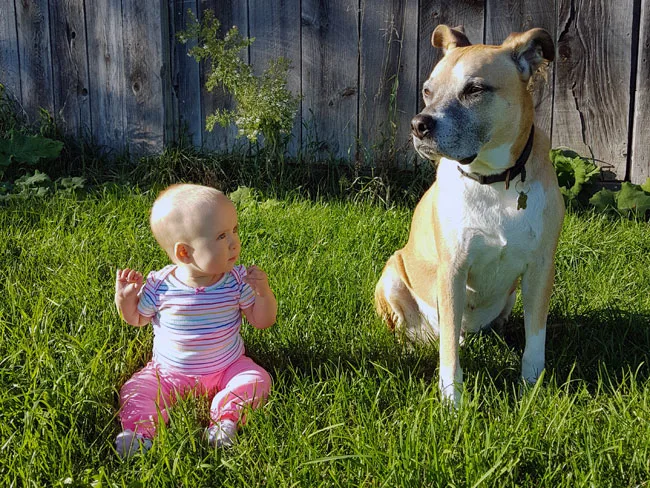
In contrast, Baxter does not have the same enthusiasm for Ellie!
I’m not saying he dislikes her. He’s just not as interested in her as she is in him.
From when we first brought Ellie home, Baxter has been very aware of her. He definitely knows she’s there and keeps an eye on what’s happening, but he’s usually not interested in being directly involved.
Baxter is a very relaxed dog, so I feel like that has made his adjustment easier. He has not seemed to be affected by her noises, smells, toys and equipment—even when balls or blocks have been flung his way.
It’s important to us that Baxter is able to interact with Ellie on his own terms—flying toys aside.
We have never forced him to smell her, sit with her or be touched by her. He’s never been a snuggly dog, so you’re not going to see pictures of him and Ellie cuddling on the couch or in his bed.
If he wants to be with us, we welcome him to whatever we’re doing. If he seems uncomfortable or moves away, we give him his space.
Baxter likes to come up and smell Ellie when we’re holding her at floor level. Ellie will sometimes try to pet him then—or occasionally stick out her tongue and try to lick him.
Walking with my dog and my baby together
Our daily walks are the best baby-dog bonding time. We all love being outside, so being able to share the fresh air and exercise together is very special.
From the very beginning, my favorite piece of baby/dog equipment was our carrier. I went through a few different versions as Ellie grew, and I’m now using a LÍLLÉbaby Complete Air Flow. This carrier offers a lot of features and allows me to carry Ellie in a few different positions.
Baxter very quickly learned the sound of me putting on the carrier, and he eagerly comes into Ellie’s room to make sure she has her snowsuit on and is ready to go for a walk.
See my post: How to teach your dog to walk next to a stroller.
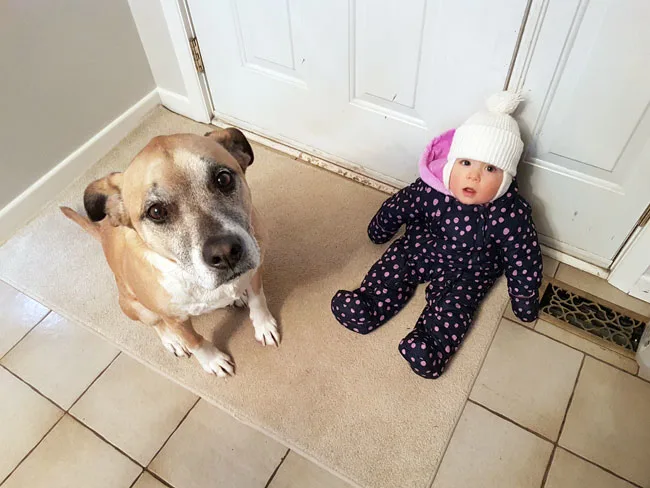
We do stroller walks occasionally, but I definitely prefer the carrier. We can hike through the woods or across the fields, rather than being confined to the sidewalk.
I have my hands free to hold the leash. And Ellie—whose preferred position is facing out—can look at everything around her. She spends most of her time swinging her head around to keep Baxter in her sights. She gasps and laughs as he runs past us.
Occasionally the daily walk and having any kind of a routine have been a challenge (as I’m writing this post, we’re in a deep freeze where it’s too cold to take Ellie outside for very long).
I feel very fortunate that Baxter is extremely patient and will pout (mostly) quietly when his walk is delayed. Having a partner or back-up plan on some days is definitely helpful.
The biggest challenge with a dog and a baby
As I said in my kick-off post for the baby prep series, Baxter occasionally doesn’t love small people. Babies are boring, but toddlers and small children with their erratic movements sometimes make him nervous.
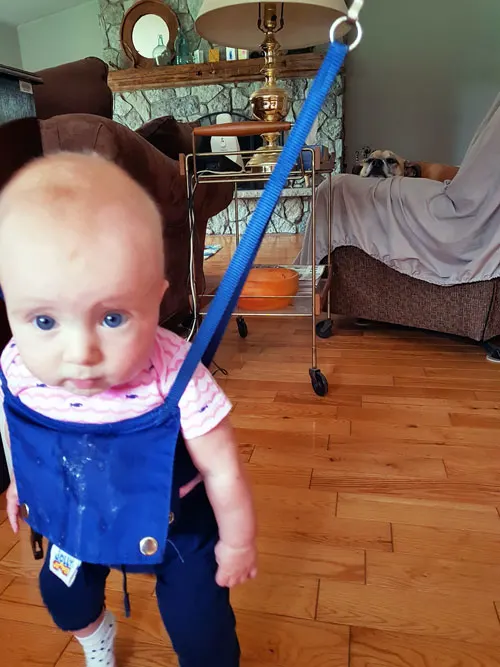
This was something I was conscious of and a bit anxious about when I was pregnant. Our trainer reassured me that Baxter would adjust and his easy-going nature would likely prevail.
However, as Ellie has become more mobile, we’ve noticed that he’s occasionally a little more uncomfortable. If she gets too close or seems to be heading in his direction, he’ll become more watchful and there have even been a few growls.
I still feel like growling is good. Growling is communication, not aggression. It’s a cue to us that he’s uncomfortable, and we need to step in. We try to reassure him and also redirect Ellie.
It’s also something that we will monitor and if his discomfort persists we will ask our trainer for help.
We have noticed that Baxter’s behaviour varies depending on where he is. In the living room, where his main bed and chair are, he usually prefers a bigger buffer between him and the baby.
In the basement or on our bed, he’s more willing to share the space and let Ellie get closer.
See our post: Creating safe spaces for dog and baby
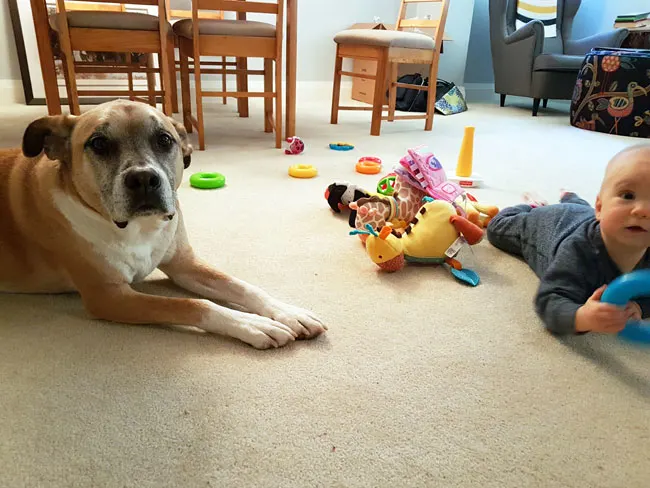
Baxter occasionally seems to feel protective towards Ellie. We had two separate situations in the early days where he growled at visitors when they came to meet Ellie, seeming displeased that strangers were touching his baby.
His protective instincts seemed to resurface a few weeks ago at my Mom’s house. She had a service tech doing some work at her house, and Baxter kept barking at the technician—not behavior I’ve seen from him before.
When I took him and Ellie into another room, Baxter laid right beside Ellie and stayed there until the service call was over.
While I don’t like Baxter to be anti-social or aggressive with anyone, I am pleased to see that he seems to care about Ellie and wants to look out for her.
Teaching the baby to respect the dog’s space
From the beginning we have been working on teaching Ellie to respect Baxter. This is part of creating a safe and happy family.
At first, it was simply saying the word “gentle” and holding her hand any time she tried to touch him—a lesson that continues every day.
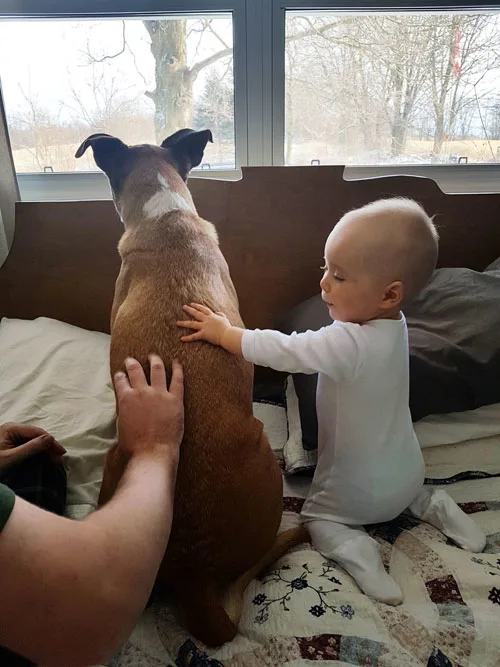
As she got more mobile, we started reinforcing that Baxter’s bed and food areas are out of bounds.
If she crawls in that direction, we tell her “no,” remove her and try to get her interested in something else—although if she sees his purple elephant toy, it’s a lost cause.
We’ve had no issue with Baxter mistaking Ellie’s toys for his, but she is obsessed with his purple elephant from Hear Doggy (silent squeaky toys are even more appreciated now, as Bax can play even during naptime).
As her understanding grows, we’re going to continue to teach her more lessons. For example, if she hears him—or any dog—growl, I want her to know that means, “I need my space. Give me a break.”
One behavior that surprised me from the baby was staring. As soon as she could roll, she would position herself in front of Baxter and stare at him.
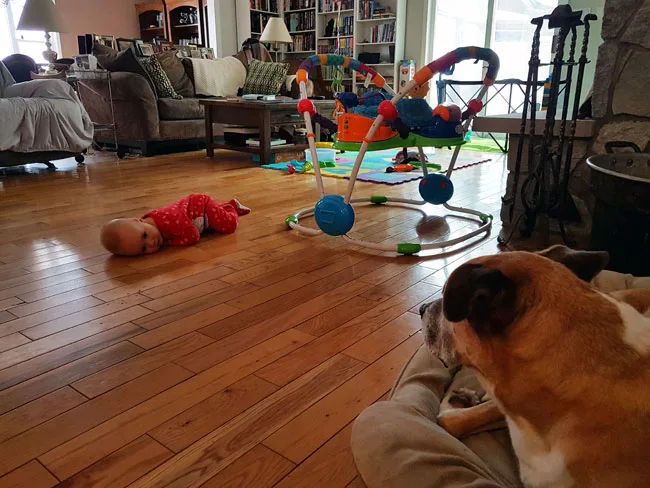
Staring is not polite dog behavior. In fact, it’s sometimes interpreted as aggression.
Even if she wasn’t very near Baxter, I could see she was making him uncomfortable. He would yawn or lick his lips, shift his position and avoid eye contact. The baby doesn’t speak English yet, let alone dog, so my solution in these moments was to redirect Ellie.
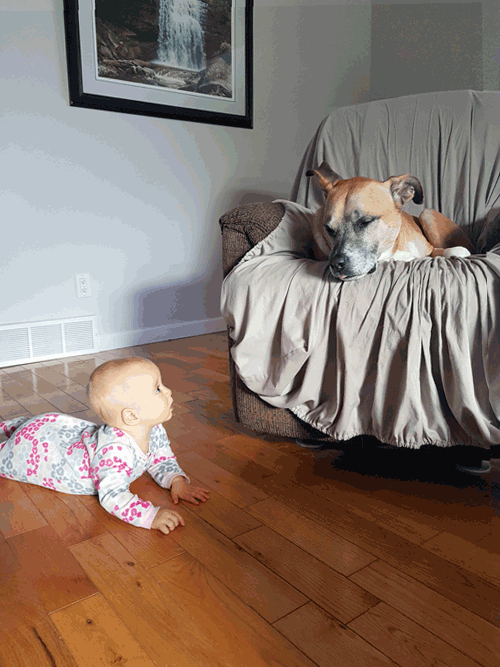
The staring has lessened as Ellie has grown. She still works to get his attention.
Now she gives him her cutest looks, performs all her tricks like clapping and peek-a-boo, and shows him her toys—all behaviors that her Daddy and I find adorable, but Baxter so far seems to be immune.
Preparing your dog for a baby pays off
Overall, I am happy with how Baxter has adjusted. I would like him to be a bit more comfortable with Ellie, but when he needs a break, his reaction is to walk away, which is the perfect response.
Whether it’s daily walks, meals or numerous other moments, there are lots of times where we’re all together, and everyone is relaxed and happy.
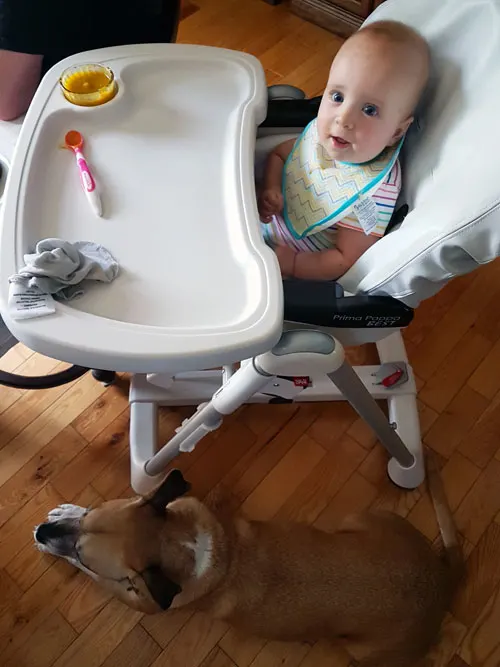
I feel like all of the preparation has made a difference. The value wasn’t just the training and practicing. It was also the thinking about situations and how I wanted to handle them.
With a new baby, it’s easy to be overwhelmed and distracted. Planning how to deal with shared spaces, the first greeting, daily walks or many other situations is very helpful.
Overall, our approach with Baxter and Ellie is cautious. We try to respect Baxter’s feelings and teach Ellie boundaries. We encourage them to be together when they want to be and don’t force them to interact when they want their own space.
Raising a child, like training a dog, is an ongoing process. So we are continuing to work with both Ellie and Baxter to ensure we all have a respectful, safe and happy relationship.
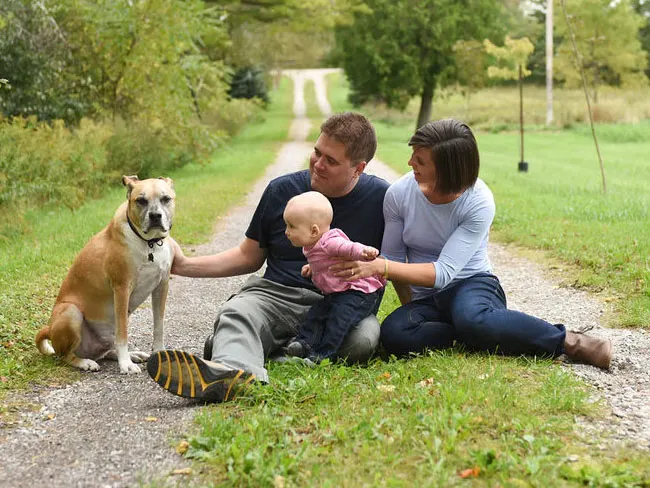
Lessons from our first year with a baby and a dog
1. Let your dog determine when and how he wants to interact.
Never force your dog into a situation that makes him uncomfortable. If your dog is overly excited and interested in the baby, work on setting up calm situations where everyone can be relaxed together.
2. Listen to your dog.
Through body language, attitude, growling and other signals your dog tells you how he’s feeling. Pay attention to what he’s saying and respect what he’s telling you. Don’t hesitate to separate your baby and dog if you feel someone needs a break.
3. Teach the baby boundaries and respect.
Setting certain spots—bed, food bowls—as dog only zones is an important part of keeping everyone relaxed and safe.
Babies also need to be taught how, where and when to pet an animal. As your baby grows, help her to understand what dogs are saying through their body language or sounds. Teach children to always ask before petting a dog.
4. Never leave your dog alone with your baby.
Even the most easy-going dog may become stressed around a baby. Being present and attentive ensures that you can help your dog if he becomes uncomfortable, teach your baby how to interact politely, and, if necessary, prevent a potentially dangerous situation from developing.
5. Have a back-up plan when you need it.
Daily walks, grooming, vet visits, even picking up dog food might be more challenging when you have a baby. Think about your needs and try to have a plan in place in case you need help. And don’t be afraid to ask for help.
6. Use equipment to make life easier.
For us, this means our carrier for our daily walks, a play yard in the living room (aka baby jail) and our robot vacuum (so I can spend my time with the baby without being overwhelmed by dog hair).
For you, it may be a dog crate, baby gate, easy-to-steer stroller or something else. Experiment to find what works for you, and don’t hesitate to change as your baby grows.
See our top gear choices for dogs and babies.
7. Consult a trainer. A trainer can answer questions, provide reassurance, offer advice and help guide you in your baby-dog journey. If you have any concerns about your dog’s behavior, don’t hesitate to reach out to an experienced, qualified trainer.
What tips do you have for preparing a dog for a baby? Any advice for training a baby to be polite to a dog?
Julia Preston is a blogger at Home on 129 Acres where she writes about her adventures of country living and DIY renovating. She and her family live on a 129-acre farm in Ontario, Canada. Follow Julia on Instagram here.

Emilia
Sunday 3rd of March 2019
I love seeing how you prepared Baxter for Ellie’s arrival on the scene, and how you are teaching her to respect him as she grows. That’s a step not everyone takes that leads to heartache for people and pets.
Julia at Home on 129 Acres
Sunday 3rd of March 2019
Thanks, Emilia. It's really important to teach our children at the same time as we're teaching our dogs. Baxter is a part of our family and he deserves Ellie's respect, like she deserves his.
Sandy Weinstein
Tuesday 26th of February 2019
wow, time does fly, she is so cute, Happy Bday Ella!
Julia T.
Tuesday 26th of February 2019
Thanks for the good wishes.
Barbara Rivers
Monday 25th of February 2019
Time truly does fly! I remember reading your "baby preparation" posts when you were pregnant.
I don't have any firsthand experience with baby/dog interactions, but your approach sounds well-thought out and makes a lot of sense to me. Great job teaching both Baxter & Ellie boundaries and to respect each other's spaces. I can appreciate the backup plan and the helpful equipment you use!
Julia T.
Monday 25th of February 2019
Thanks for following along through this whole process! Thinking things through has been so helpful and probably one of the biggest lessons I've learned over this time.
Kim Chappell
Monday 25th of February 2019
For now I would make sure dog food is not in a dish on the floor, feed in a closed crate. I would give the dog a lot more structure, he needs to understand the humans are in charge. PLACE command, structured walks, crate training would help.Dog should ask to be on furniture, not a free for all. If dog is already growling it has gone too far. Glad to see parents are picking up on subtle things the dog is doing, very good, these are warnings before the growl. Usually the child is not a real threat until they can stand, and look the dog eye to eye or taller, then they are going to be treated differently. I recommend reading "The Hammer" by Bryan Bailey, it explains why dogs bite, and ways to prevent it.
Julia T.
Monday 25th of February 2019
Thank you for your input, Kim. And for yours as well, Lindsay.
Lindsay Stordahl
Monday 25th of February 2019
Hi Kim, those are all great points and some I would definitely consider for Remy if we were planning a baby. He is a dog who needs a ton of structure, due to his high energy and personality (he's pretty "impressed" with himself). Thank you for the book recommendation too. I used to feed Remy in a crate when we had two dogs since it was easier for me. The place or "go to your bed" is always a useful command too, and we don't allow Remy on any furniture at all.
Julia has done a really great job with Baxter and Ellie. I think she has found the right balance with structure for Baxter but it's always good to keep re-visiting these things. It will definitely be a bit different as Ellie starts moving around more, I'm sure!